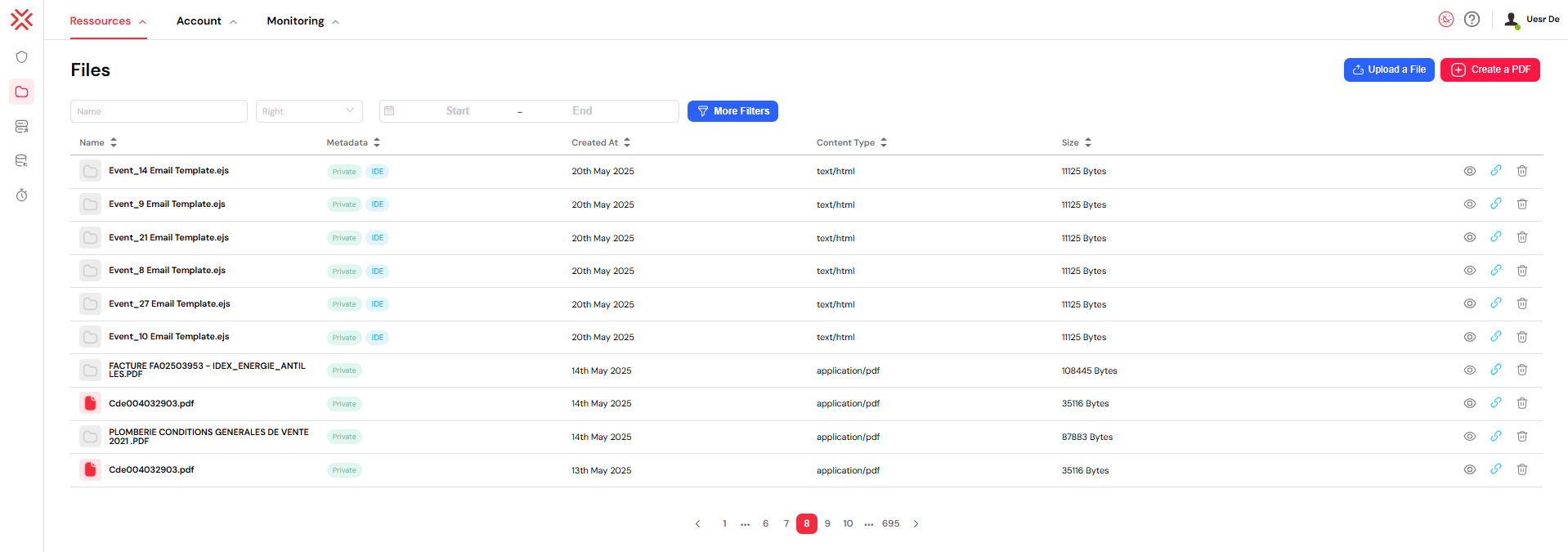Files Management in Softyflow
The Files section in Softyflow provides a comprehensive file management system that allows users to upload, organize, view, and manage various types of files within their projects.
Overview
The file management interface displays all uploaded files in a structured table format, providing detailed information about each file including metadata, creation dates, file types, and access permissions.

File Upload
Uploading Files
- Click the "Upload a File" button in the top-right corner
- Select files from your local system
- Choose visibility settings:
- Public: File can be accessed by others
- Private: File is only accessible to you
- Click upload to complete the process

Supported File Types ??
The system supports various file types with dedicated icons:
- CSS files (.css) - Styling documents
- PDF files (.pdf) - Document files and templates
- JavaScript files (.js) - Script files
- Images (.png, .jpeg, .tif, .gif) - Image files
- Generic files - All other file types
File Information Display
File Table Columns
Name
- Displays the filename with an appropriate file type icon
- Icons are color-coded based on file type for easy identification
- Clicking on a file name opens the file for editing or preview
Metadata
- Visibility Tags:
Public(red tag) - File is publicly accessiblePrivate(green tag) - File is private
- Source Tags:
IDE(blue tag) - File created within the IDEUser(blue tag) - File uploaded by user
- Storage Tags:
S3(yellow tag) - File stored in S3 bucket
Created At
- Shows the upload date
- Formatted for easy readability
Content Type
- Displays the MIME type of the file
- Helps identify file format and handling requirements
Size
- Shows file size in bytes
- Useful for storage management
File Operations
Viewing Files
- Click the View button (eye icon) to open the file
- PDF templates open in a special preview mode
- Other files open in a new tab for viewing/downloading
Copying File URLs
- Click the Copy button to copy the file's direct URL
- Useful for sharing or embedding files
- Success notification confirms the URL has been copied
Deleting Files
- Click the Delete button (trash icon)
- Confirmation dialog prevents accidental deletion
- Files are permanently removed from the system
Filtering and Search
Basic Filters
- Name: Search files by filename
- Visibility: Filter by Public or Private files
- Date Range: Filter files by creation date range

Advanced Filters
Click "More Filters" to access additional options:
- Content Type: Filter by specific MIME types
- Clear all filters using the "Clear filter" option

Filter Behavior
- Filters are applied in real-time
- Multiple filters can be combined
- Results update automatically as you type
Pagination and Sorting
Pagination
- Navigate through large file collections
- Configurable items per page (default: 10)
- Page navigation at the bottom of the list
Sorting
Files can be sorted by:
- Name (filename)
- Created At (upload date)
- Content Type (file type)
- Size (file size)
- Metadata (visibility and tags)
Click column headers to sort in ascending or descending order.
Special File Types
PDF Templates
- Files with
.PDFtemplateextension receive special treatment - Generate PDFs with variables and dynamic content
- Access through the "Create a PDF" button
- Preview functionality shows generated PDF output
IDE Files vs User Files
- IDE Files: Created within the Softyflow IDE environment
- User Files: Uploaded directly by users
- Different handling and processing based on source
File URLs and Access
Public Files
- Accessible via direct URL:
/uploads/{fileId}/name/{filename} - Can be shared with external users
- No authentication required for access
Private Files
- Restricted access based on user permissions
- Require authentication to view
- Secure file handling
Best Practices
File Organization
- Use descriptive filenames for easy identification
- Set appropriate visibility (Public/Private) based on content sensitivity
- Regularly review and clean up unused files
- Use content type filtering to locate specific file types quickly
Storage Management
- Monitor file sizes to optimize storage usage
- Delete obsolete files to maintain system performance
- Use date filters to identify old files for cleanup
Security Considerations
- Mark sensitive files as Private
- Regularly audit Public files for security compliance
- Use appropriate file naming conventions to avoid conflicts
Troubleshooting
Upload Issues
- Ensure file size is within system limits
- Check file type compatibility
- Verify network connection for large uploads
Access Problems
- Verify file visibility settings
- Check user permissions for private files
- Ensure correct file URLs are being used
Performance
- Use filters to reduce dataset size for faster loading
- Consider pagination for large file collections
- Regular cleanup improves system responsiveness